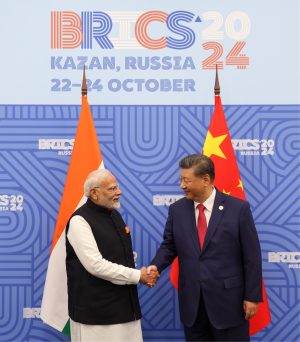India and China reached a border patrol agreement after years of prolonged negotiations, at both the diplomatic and military levels. That paved the way for the first bilateral meeting since October 2019 between Chinese President Xi Jinping and India’s Prime Minister Narendra Modi.
While Xi and Modi held an ‘impromptu meeting’ along the sidelines of the 2023 BRICS summit in Johannesburg, where the leaders held a “candid and in-depth exchange of views,” it was clear that both sides were not on the same page. The official statements issued at that time offered different interpretations of the meeting.
The 2024 BRICS summit hosted by Russia presented a completely different picture. The ceremonial handshake at Kazan sent a strong signal that India and China are ready to move on to the next phase of their relations.
Yet, there are reasons to temper such optimism. As of now, the Indian Ministry of External Affairs and Chinese Ministry of Foreign Affairs have disclosed little about the details of the agreement in their public statements. This is likely because negotiations are ongoing.
In the words of India’s Minister of External Affairs S. Jaishankar, although “complete” disengagement has been arrived at, de-escalation – which would involve gradual removal of troops – remains elusive. India and China had already agreed to disengagement at five of the seven friction points before the recent agreement.
The latest patrolling agreement covers Depsang and Demchok, where resolutions to end the standoff remained stalled over the past 24 months. This is no mean feat itself, since China has consistently maintained that the situation is this area is a legacy issue, while India viewed it as part of the escalation in April-May 2020. However, the new agreement does not allow Indian troops to go back to pre-2020 patrolling in the north and south banks of Pangong Tso, nor in Gogra and Hot Springs.
It is also worth noting that while Modi and Xi called for an early meeting of the special representatives on the India-China boundary question (National Security Adviser Ajit Doval from the Indian side and Foreign Minister Wang Yi from the Chinese side), it remains unclear when the next China-India corps commander-level meeting will be held.
The last meeting between the corps commands of the two sides was held in February, making the eight-month gap between two rounds of talks the longest since they began in 2020. As noted by Indian analyst Jabin T Jacob, the absence of high-level military officials during the patrolling agreement announcement was also quite striking.
On the Indian side, pressure from the Indian business lobby played a decisive role in pushing the Modi government to reach an agreement with the Chinese, as Indian companies remain heavily reliant upon Chinese manufacturing supply chains and technology. While Finance Minister Nirmala Sitharaman was quick to clarify that India will retain curbs on “border nations” – a veiled reference to China – it is clear that policymakers are thinking seriously about increasing trade and investment with China.
The Economic Survey 2023-24, released earlier this year, made a case for greater FDI inflows from China to boost exports and address the growing bilateral trade deficit with China. While the recent patrolling agreement is unlikely to overhaul trade relations – this would require policy revisions over a long time – it does open up space for such a possibility. In line with India’s consistent position that other bilateral issues cannot be addressed until peace on the border is restored, this agreement paves the way for New Delhi to move forward with much-needed trade and investment from China.
For China, the implicit softening of its stance on the border question with India can be understood against the backdrop of Beijing’s push to engage with Global South countries. The Global South not only presents a vital market for Beijing, but engagement with developing countries can help China improve its international image whilst challenging the Western-led liberal order.
With Beijing intensifying tensions in the heavily militarized South China Sea dispute, adopting a conciliatory tone on the question of the border dispute with India may help promote the image of China’s “peaceful rise,” which has been questioned with greater intensity and frequency in recent years.
In light of New Delhi’s success in projecting itself as the voice of the Global South, especially with hosting the G-20 summit where the African Union was included as a member, Beijing will try to make New Delhi its ally, rather than get entangled with India in a contest for influence.
This explains why the Chinese readout of the Modi-Xi meeting referred to India and China as “important members of the Global South,” who “must also shoulder their international responsibility, set an example in boosting the strength and unity of developing countries, and contribute to promoting a multipolar world and greater democracy in international relations.”
Finally, one cannot escape the sense of déjà vu that comes with China-India relations. Following the defusing of the Doklam standoff, Modi and Xi met at Wuhan in China for an informal summit. Optimism was high. Many believed the summit was a “game changer” and would provide the much-needed “reset” in Sino-Indian bilateral ties.
With the advantage of hindsight, it is clear that this wasn’t the case. Two years later Indian and Chinese troops clashed violently along the Line of Actual Control at Galwan Valley, pushing bilateral relations into a downward spiral.
Lessons from the past teach us that China-India relations do not fit in the neat binaries of friends or foes. It is clear that a thaw at this moment in history works in favor of both countries; however, this is in no way a guarantee of prolonged peace.
































